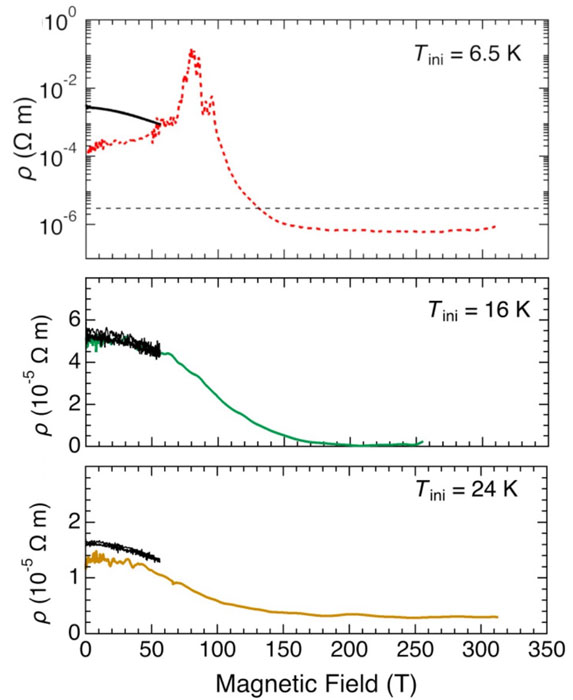Closing the Hybridization Charge Gap in the Kondo Semiconductor SmB6 with an Ultrahigh Magnetic Field
Y. Matsuda Group
In materials with strong electron correlation, the nontrivial energy-band structure beyond the single-electron picture gives rise to exotic properties. SmB6 is a typical Kondo semiconductor, whose hybridization gap has been estimated to be 5–20 meV. In addition to the strong electron correlation in SmB6, the valence fluctuation of the Sm ion and possible topological surface state induce a complicated energy band structure. Under sufficiently high magnetic fields, the energy bands are shifted by the Zeeman effect and the evolution in magnetoresistance gives information to understand the complicated electronic states. However, an ultra-high magnetic fields above 100 T is required to achieve the field-induced semiconductor–metal (S–M) transition, which leads to the difficulty in observing the details of the evolution of the magnetoresistance up to the S–M transition in SmB6 with high sensitivity.
In this research, we utilized the electromagnetic flux-compression (EMFC) technique [1] to generate ultra-high magnetic fields up to 320 T. The high-frequency electrical resistivity was measured using a contactless radio-frequency impedance measurement method developed by the authors [2], which demonstrates the observation of the upper critical magnetic field in cuprate superconductor [3] and the S–M phase transition in narrow-gap semiconductor [4]. The measurement SmB6 sample (typically 1 × 1 × 0.05 mm3) was mounted on a self-resonant spiral probe coil with the diameter of 1 mm so that the 〈100〉 axis was parallel to the magnetic field. A radio-frequency voltage tuned around 700 MHz was applied to the probe coil and the reflected signal was acquired by the digital oscilloscope. The amplitude of reflected signal was obtained by the numerical lock-in method, and then converted to electrical resistivity by using the temperature dependence of signals measured just before applying the pulsed magnetic field.
Figure 1 shows the magnetic field dependence of the high-frequency electrical resistivity at 6.5 K, 16 K and 24 K (initial temperature just before applying the pulsed magnetic field) obtained from independent EMFC experiments up to 320 T [5]. The AC (50 kHz) magnetoresistances up to 55 T generated by the non-destructive pulsed magnet are also presented for comparison (black curves). At 16 K and 24 K, the data obtained by the EMFC and non-destructive magnet experiments coincide well each other, indicating the high reliability of the results of EMFC experiments. The high-frequency resistivity gradually decreases with increasing the magnetic field and the field-induced S–M transition appears around 180 T by closing the hybridization gap in SmB6. On the other hand, at 6.5 K, the resistivity obtained by the EMFC experiments significantly increases up to ~80 T, different from the result of non-destructive magnet experiment. This indicates a significant frequency dependence of electrical resistivity at low temperatures, and the scattering process for the carriers changes around 80 T at low temperatures. This is also suggested by an anomaly of temperature dependence of the electrical resistivity around 12.5 K under zero magnetic field.
Figure 2 presents the phase diagram of SmB6 constructed based on the experimental findings in the present research [5]. Four black dashed-dotted and dotted curves represent the temperature evolution in the sample during the independent EMFC experiments, which arises from the extremely short pulse of the magnetic field generated by the EMFC technique.

Fig. 2. Temperature–magnetic field phase diagram of SmB6. B1 (closed circle) and Bhyb (closed square) are taken from the results of the EMFC experiments. critical temperature T * (closed triangle and diamond) is taken from the nondestructive magnet and PPMS experiments. The thin dashed-dotted and dotted curves indicate the temperature evolution during the magnetic-field pulse. Each state is separated by bold guidelines for a clear view, whose identifications are described in the main text.
By connecting the boundary points (the fields exhibiting the anomalies in the resistivity), four independent states (S1, S2, M′, and M) are defined in the phase diagram. Semiconducting state S1 is phenomenologically characterized by frequency-independent magnetoresistance and metallization at Bhyb ~ 180 T. The high-field M phase is likely to be a normal paramagnetic metal. The low-temperature semiconducting state S2 exhibits frequency-dependent magnetoresistance, and becomes metallic in the low-frequency transport at B1 although the hybridization gap is still open. We suggest that the observed transition at B1 relates with the energy scale of quasiparticles such as the spin polaron in the in-gap state.
References
- [1] D. Nakamura et al., Rev. Sci. Instrum. 89, 95106 (2018).
- [2] D. Nakamura, M. M. Altarawneh, and S. Takeyama, Meas. Sci. Technol. 29, 035901 (2018).
- [3] D. Nakamura et al., Sci. Rep. 9, 16949 (2019).
- [4] D. Nakamura et al., Phys. Rev. Lett. 127, 156601 (2021).
- [5] D. Nakamura et al., Phys. Rev. B 105, L241105 (2022).

